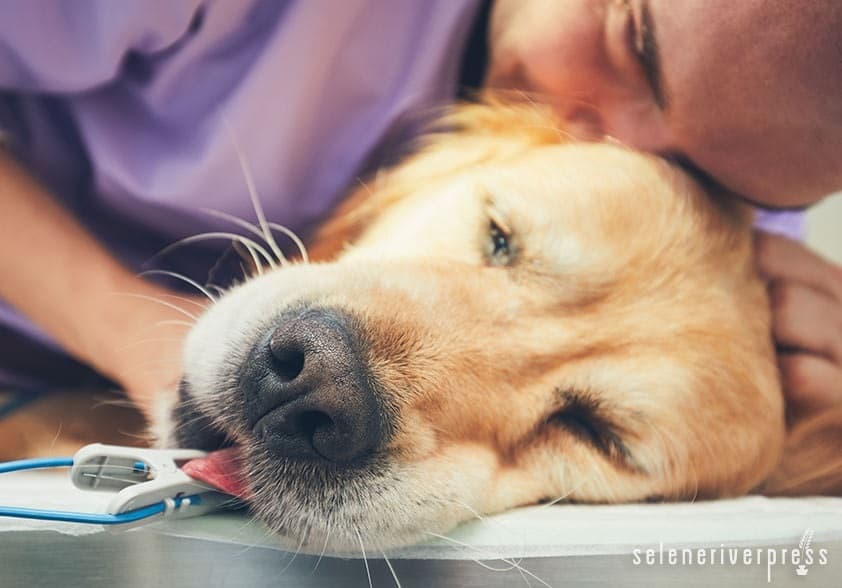One of the hardest decisions pet owners have to make is deciding when it’s time to put their companions to sleep. But addressing the topic and discussing your options while your pet is still healthy will make it that much easier when the time comes around. I recommend that you start by making a list of your pet’s five favorite activities. These might include running to the door to greet you when you get home, fetching balls, or enjoying treats, catnip, toys, etc. You may decide it’s time to say goodbye when your pet no longer enjoys two of his favorite things. Or three. Or all five. This is a personal decision, and each case is different.
Evaluating your pet’s quality of life can be challenging and difficult. Ohio State University Veterinary Medical Center has put together a great quality-of-life questionnaire you can download and fill out. This can help you decide whether or not it’s time to say goodbye or give it some more time before reevaluating the questionnaire in another month of two. Put yourself in their paws.
Such questionnaires allow you to focus on specific indications: disinterest in their favorite activities, displays of discomfort such as crying out loud, sensitivity to touch, depression, loss of appetite, rapid and/or shallow breath. In many situations, it’s a good idea to take your pet to your veterinarian and evaluate their well being. Your vet may decide to run blood work or offer additional tests to check how your pet’s body systems are functioning. They may recommend medications, supplements, or alternative treatments such as acupuncture, laser, massage, or chiropractic to help keep your pet comfortable and give them the best quality of life possible. Honesty from friends and family can be a great resource too. Others may notice how Fluffy was doing months ago as compared to now. Keep in mind, when we spend time with our pets every day, we don’t always notice the subtle changes in their appearance or behavior.
Another thing to consider is aftercare, of which you have several options. One is private cremation, which enables you to keep your pet’s ashes in an urn or other special container in your home, or to receive an environmentally friendly urn for burial. You may also elect to not have the cremains returned to you at all. This is an affordable and convenient option for those who don’t have a yard or who can’t bury their pet at home. If you do decide on a private burial in your yard, keep in mind that one day you may relocate to a new home. And although burial at home is preferred by many, it may not be practical or permitted in your area. Be sure to check your local zoning restrictions. Whatever you decide on, when you call to schedule your appointment, discuss all your options and arrange prepayment for services. This will make for a pressure-free experience at a difficult time.
Grief support is important for yourself, for your children if you have them, and even for other pets at home. The death of a pet can have a huge impact on everyone. Our pets are a part of the family, and we share a very special bond with them. You may find comfort in planting a tree in remembrance, writing a poem, providing a service, or having a paw print made. There are many grief counselors available if you’re not able to get past the sorrow. The most important step you can take is to be honest about your feelings.
Once you decide it’s time to say goodbye, you should inform yourself about the procedure and make the best decisions for you. Whether it’s done in the clinic or at your home, most people choose to be with their pets during this transition. Each veterinarian has their own protocol. In most cases a tranquilizer is given in tablet form or as a simple injection under the skin, much like a vaccination. The tranquilizer is used to decrease anxiety, fear, tension, agitation, and disturbances of the mind. Next, an intravenous catheter may be placed in the arm or back leg to insure a clean injection of the solution. At this point your pet will be calm and relaxed as you talk and caress them. Once the solution has been administered, your pet will drift into a deep sleep of unconsciousness. Your vet will then listen to the heartbeat to confirm death and let you know when they’ve passed on. Your vet will probably leave the room and give you the opportunity to be alone with your pet. Be aware that the body may release urine and feces upon death, and this is a normal response due to muscle relaxation. Unlike what you may have seen depicted in movies, their eyes will remain open, and sometimes there can be muscle spasms and/or sounds as the air and energy leave your pet’s body. This doesn’t mean your pet is in pain or still alive; it’s simply part of the process that occurs after death.
Remember that you’ve given your pet the ultimate gift of love and devotion by helping them cross the Rainbow Bridge in peace and tenderness.
Image from iStock/Chalabala.


